The 3 Best Invisible Hearing Aids of 2025 (Audiologist-Reviewed)
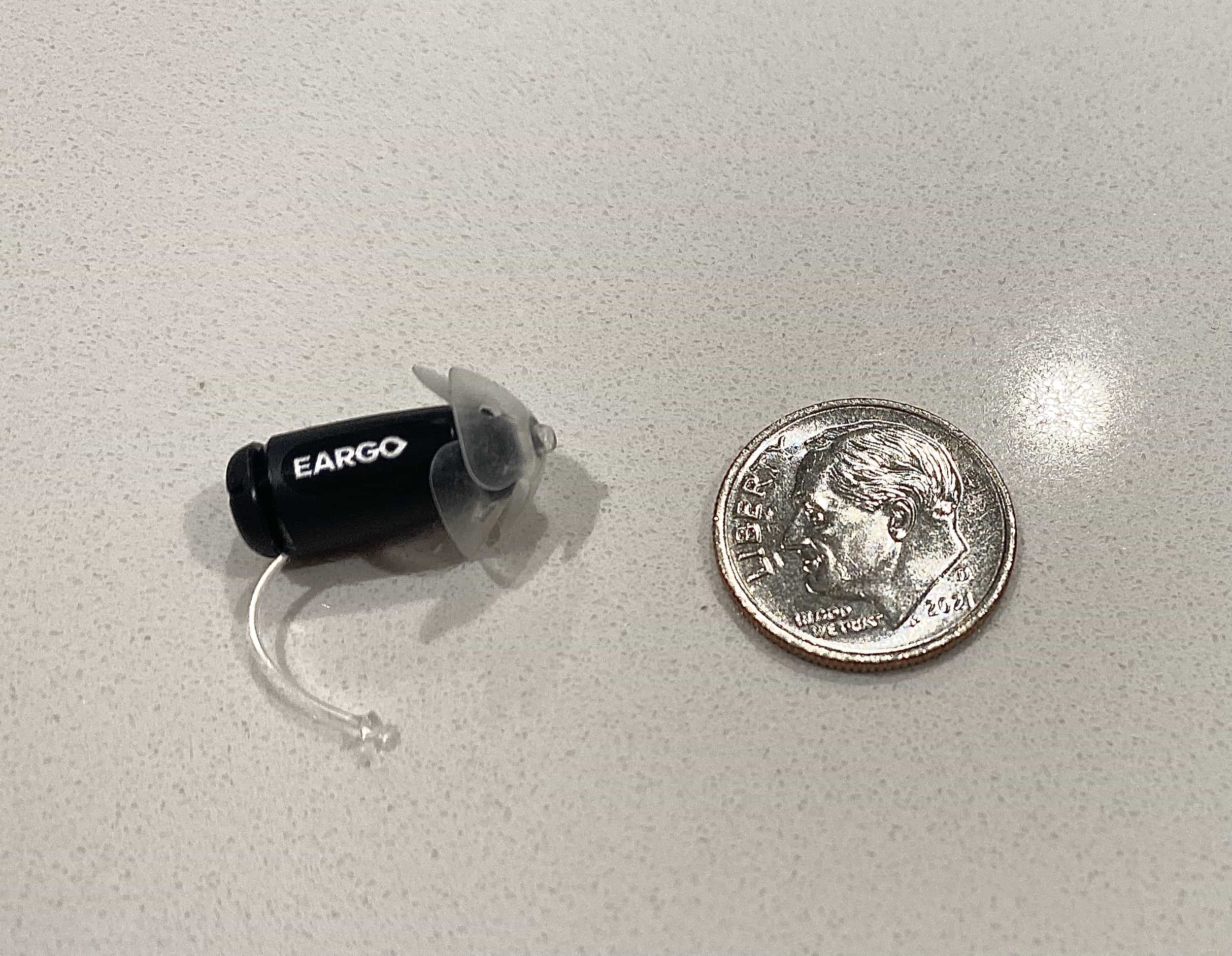
Are you looking for hearing aids that fit discreetly in your ears? We tested 12 models from eight brands to find the top invisible hearing aids on the market today. The Eargo 7 leads our list, with automatic sound adjustments and lifetime specialist support, while MDHearing offers budget-friendly options for under $500 per pair. We evaluated each device based on size, pricing, sound quality, professional support, and technology to help you find the perfect discreet solution for your hearing needs.
Key Findings
- Eargo hearing aids are nearly invisible when worn, and they can be adjusted through a companion smartphone app.
- MDHearing offers invisible hearing aids for under $500 for a pair.
- Audicus hearing aids offer automatic sound adjustments, allowing users to travel between different sound environments without manually adjusting the devices.
FYI: To learn about this year’s top-rated hearing aids, check out our guide to the overall best hearing aids.
Why Trust Us?
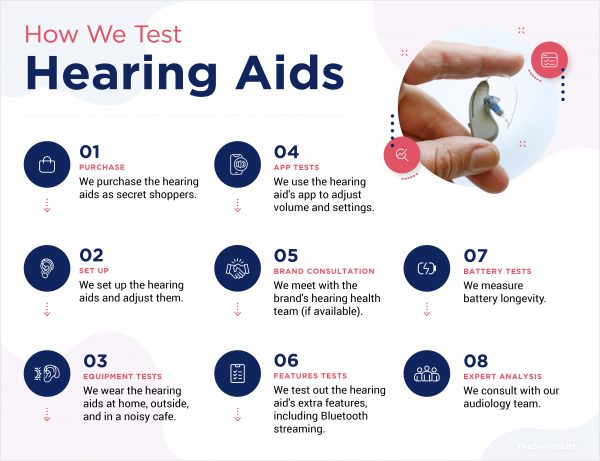
To create this list, we tested 12 different invisible hearing aids from eight brands. Here is how we evaluated each device:
- Size: We looked into companies that offer discreet hearing aids in various sizes and a comfortable fit inside the ear canal. The hearing aids that made the cut were lightweight and so small they’re hardly noticeable.
- Pricing: Since neither insurance nor Medicare covers hearing aids, we looked for devices that cost $2,500 or less per pair.
- Sound quality: We tested each hearing aid in various environments (at home, in a restaurant, in group conversation, and in a park) to determine how well they amplified the sounds we wanted to hear.
- Professional support: Particularly with OTC hearing aids, which don’t require an audiologist prescription, it’s crucial to find a hearing aid brand with reliable remote support.
- Technology: We also considered hearing aids’ extra features that can make them more useful, such as smartphone apps and automatic adjustments.
Did You Know: Approximately 29 million U.S. adults could benefit from hearing aids, according to the National Institute on Deafness and Other Communication Disorders.1 But fewer than one-third of adults 70 and older who could benefit from hearing aids have ever used them.
Best Invisible Hearing Aids
- Eargo 7 : Best Sound Quality
- MDHearing Neo XS : Best Budget Option
- Audicus Mini 2 : Lifetime Audiology Support
Our Favorite Invisible Hearing Aids of 2025
|
Eargo 7
 |
MDHearing Neo XS
 |
Audicus Mini 2
 |
|
|---|---|---|---|
| Rating out of 5 | 4.4 | 4.3 | 4.4 |
| Cost for a pair | $2,699 |
$397 |
$2,498 |
| Warranty | 2 years |
1 year |
2 years |
| Standout features |
|
|
|
| Read More | Eargo 7 Review |
Our Top Picks
Eargo 7 - Best Sound Quality

866-334-3974
What We Like Most:
- Virtually invisible when worn
- Lifetime licensed support
- Useful smartphone app
- IPX7 water-resistance
Overview
Cost for a pair: $2,699
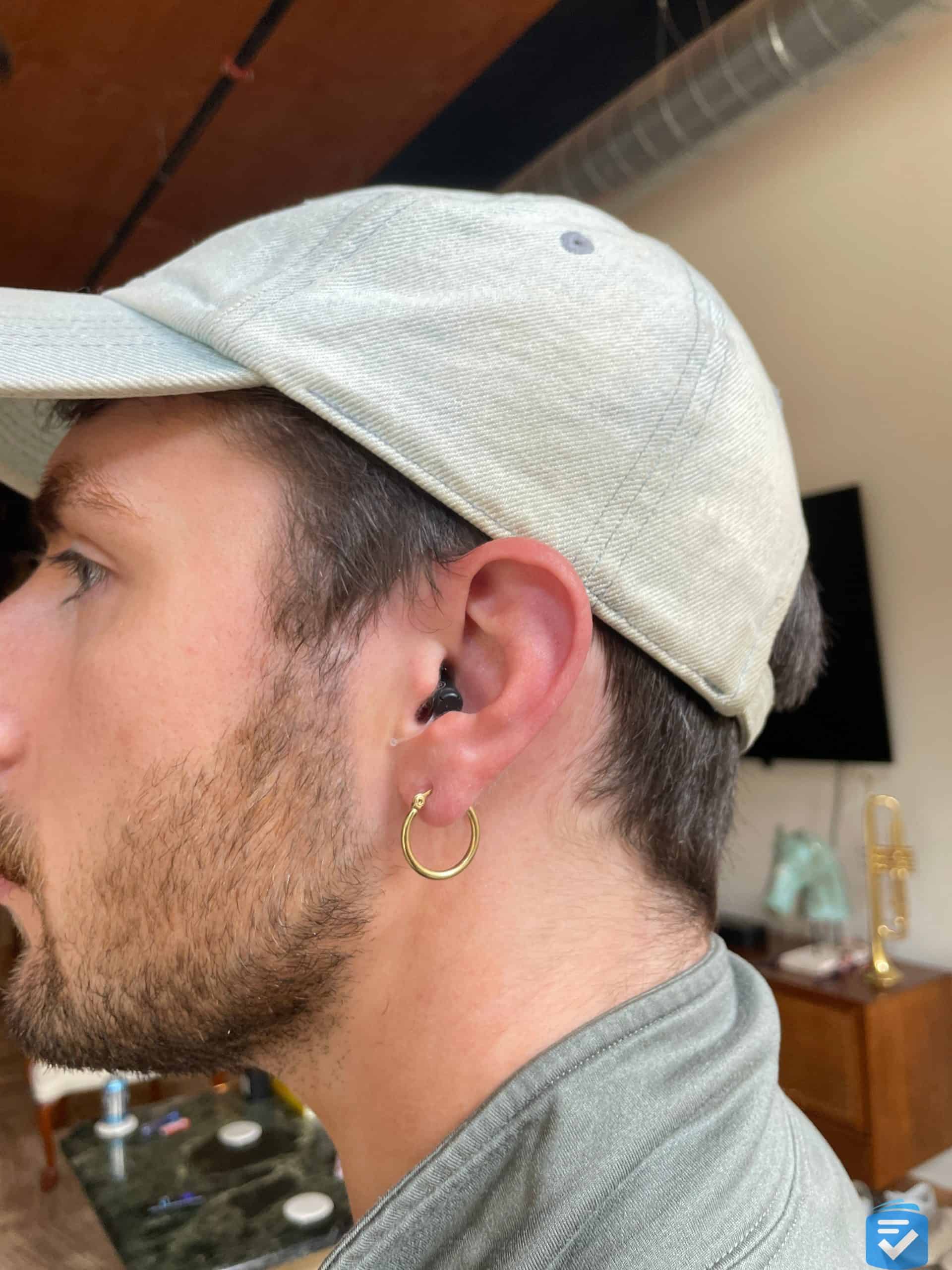
Featuring a sleek design, a multifaceted smartphone app, and advanced automatic sound adjustments, the Eargo 7 is our top pick for best invisible hearing aid. These hearing aids feature rechargeable batteries that lasted 19 hours in our tests, which was more than enough to get us through the day. It also performed well in all environments where we conducted testing. Whether during a quiet hike or in a crowded restaurant, these hearing aids helped amplify the sounds we wanted to hear while drowning out unwanted background noise.
When we tested the Eargo 7 in a noisy coffee shop, we were impressed by how quickly the Sound Adjust+ technology adapted. Background conversations were automatically filtered out, making it much easier to communicate with the barista. Compared to the MDHearing Neo XS, the Eargo 7 more effectively filtered ambient noise while keeping speech clear. Even on windy days, we noticed these hearing aids effectively reduced wind noise compared to other models from other brands.
>>Read More: Eargo 7 Review
Much like earlier Eargo models, the Eargo 7 is compatible with Eargo’s smartphone app. We like that we could also manually adjust the volume and frequency levels when needed or when the automatic adjustment misses the mark. The Eargo 7 also includes free lifetime remote support from their team of hearing specialists. Through the app, we could make appointments with a hearing specialist who remotely adjusted our hearing aids to better suit our preferences.
The primary downside of these hearing aids is the lack of Bluetooth audio streaming. With Jabra Enhance hearing aids, for example, you can stream music and calls to your hearing aids. Eargo (and most other invisible hearing aids) lack this functionality.
To learn more about Eargo’s models, read our hands-on Eargo review.

Pros
- 19-hour battery life
- Sound Adjust+ technology
- Lifetime remote support included
- Incredibly small design
- Two-year warranty
Cons
- No Bluetooth audio streaming
- More expensive than competitors
MDHearing Neo XS - Best Budget Option

800-456-2308
What We Like Most:
- Virtually invisible when worn
- Lifetime licensed support
- Useful smartphone app
- IPX7 water-resistance
Overview
Cost for a pair: $397
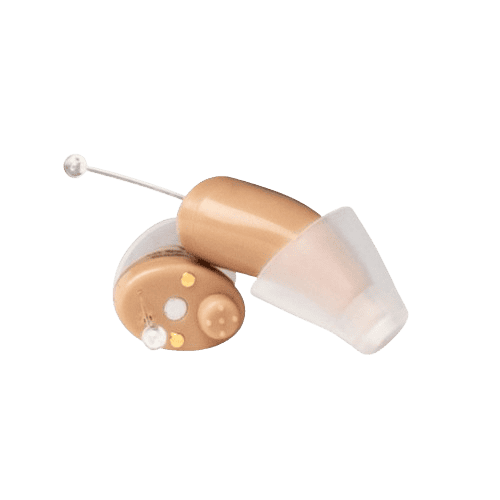
If Eargo hearing aids are too pricey, you might prefer the MDHearing Neo XS, which is a similar invisible style at less than a quarter of the cost. While the Neo XS forgoes smartphone app controls and automatic sound adjustments, we found that these hearing aids deliver great sound quality and advanced noise reduction. We can’t say the same for most invisible hearing aids at the same price point.
We tested the Neo XS during our daily activities, and it didn’t fail to impress. Watching TV at home, the sound came through clearly without a need for adjustments. Outside and in more complex environments, however, we had to manually adjust the hearing aids because, unlike the Eargo 7, the Neo XS doesn’t make automatic adjustments.
We found it easy to make adjustments on the Neo XS, however. Physical buttons let us toggle between different sound environments and adjust the volume. Those intuitive controls are also great for wearers who might not be comfortable using a smartphone. But if you prefer smartphone control, we recommend Eargo and Audicus hearing aids instead. We also recommend those brands if you want longer battery life: The Neo XS’s 18-hour battery capacity is great, but it’s the lowest on this list.
FYI: According to the American Academy of Audiology,2 untreated hearing loss is linked to increased risk of falls, depression, anxiety, and even dementia.
To learn more about the Neo XS and the other models from MDHearing, read our full MDHearing review.
Pros
- Significantly more affordable than competitors
- 18-hour battery life
- Four different environment settings
- 45-day risk-free trial
- Lifetime support included
Cons
- No Bluetooth audio streaming
- No smartphone app adjustments
Audicus Mini 2 - Lifetime Audiology Support

What We Like Most:
- Completely in-ear design
- Two-year warranty
- Lifetime Audicus support
- 20-hour battery life

Overview
Cost for a pair: $2,498
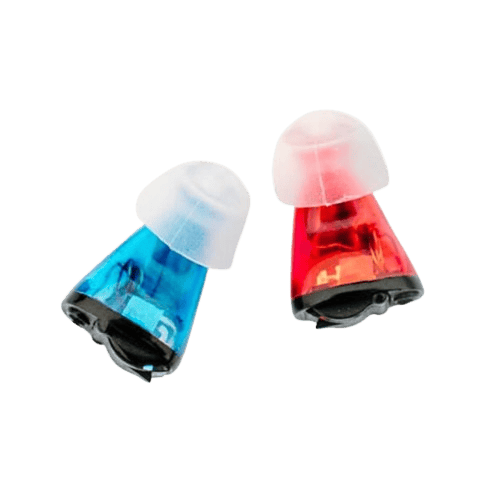
The Audicus Mini 2 offers the perfect balance of an invisible form factor and impressive battery performance. In our tests, the rechargeable batteries lasted a full 20 hours on a single charge, outlasting both the Eargo 7 and MDHearing Neo XS. We didn’t run out of power on multiple full-day testings, even on jam-packed days that include morning walks, afternoon meetings, and dinners at bustling restaurants.
More importantly, the Mini 2 maintained consistent performance throughout the day, and we particularly appreciated the convenience of placing them in their charging case overnight rather than dealing with tiny disposable batteries.
Much like Eargo’s models, the Audicus Mini 2 features automatic sound adjustments. When we tested these hearing aids in a noisy restaurant, we noticed the background noise reduction kick in. When we left the restaurant and walked down a quiet street, the hearing aids allowed us to hear more background noise. We also appreciated the Audicus app: When the automatic adjustments weren’t sufficient, we could pull out our smartphones and manually adjust them.
Pro Tip: The Audicus Mini 2’s rechargeable design makes it an excellent option for seniors with dexterity issues who struggle with the tiny disposable batteries used in many hearing aids.
While the Audicus Mini 2 is the most expensive hearing aid on this list, it’s also the only option with a two-year warranty and the longest battery life, which could justify the higher price tag.
Pros
- Two-year warranty
- 45-day trial period
- Lifetime expert support
- Great sound quality
- 20-hour rechargeable battery life
Cons
- Higher price
- No disposable battery option for travel
FYI: The Audicus Mini 2 is actually manufactured by WS Audiology (Widex and Signia) and is programmed to your hearing loss, where Eargo 7 and MDHearing Neo XS come with pre-set profiles for the most common hearing losses.
Honorable Mentions
While the following hearing aid brands didn’t make the cut, we thought they offered invisible hearing aid models worth a second look.
- Starkey: Starkey is known for making the first invisible hearing aids, and the company’s Picasso model demonstrated superior sound quality. However, their hearing aids are on the higher end, pricewise — up to $6,000 for a pair — which is why they didn’t make our list.
- Audien: Audien hearing aids cost as low as $100 for a pair, but their poor sound quality prevents them from being very useful.
- Phonak: Phonak’s Lyric hearing aid can be worn for months without being removed, but we didn’t include this model on our list due to its high prices. Read our Phonak review to learn more.
- Widex: Although the Widex Moment had very impressive sound quality, its app was a bit cumbersome, and its prices were high, even for prescription hearing aids.
Did You Know: Approximately 1.5 billion people worldwide live with some degree of hearing loss, and this number is expected to grow to 2.5 billion by 2050, according to the World Health Organization.3
Types of Invisible Hearing Aids
There are two types of invisible hearing aids: completely-in-canal hearing aids (CIC) or in-the-canal (ITC) hearing aids.
Completely-in-canal hearing aids are easily customizable to your ear shape, hidden in your ear canal,4 and nearly invisible. They’re suitable for individuals with a wide range of hearing loss, particularly people with mild-to-moderate hearing loss. Although CIC hearing aids are virtually invisible, a tiny piece of the device remains visible for easy removal.
When we wore the Eargo 7 CIC hearing aids, we were impressed by how discreetly they sat in the ear canal. Even someone looking directly at us from a few feet away couldn’t tell we were wearing hearing aids, which is ideal for users concerned about stigma or appearance.
In-the-canal hearing aids are also intended for individuals with mild-to-moderate hearing loss, but they tend to have more advanced features than CIC hearing devices. Just like CIC devices, ITC hearing aids are discreet and sit deep in the canal, where they are virtually invisible. ITC hearing aids can be customized to fit the shape of your ear comfortably, but assistance is required to remove them from your ears.
How to Choose Invisible Hearing Aids
When you’re looking for the best discreet hearing aids, it’s important to consider features such as noise reduction, telephone features, multiple channels, and tinnitus relief.
Noise Reduction
This is an important feature for many modern, high-tech hearing aids. A noise-reduction feature in your hearing aids can help reduce loud noises or eliminate buzzing and whistling sounds in the background.
Telephone Features
Look for hearing aids with upgraded Bluetooth or wireless connectivity. Your hearing aids should be able to connect to your iPhone or Android phone so you can easily answer calls or stream music directly through them. If you primarily use an office or home phone, you should ensure you get a hearing aid with a telecoil. According to the FCC,5 hearing-aid-compatible landline telephones should work with telecoils, which help eliminate excess noise.
Tinnitus Relief
Hearing aids for tinnitus are a great way to manage the buzzing, ringing, and whirring sounds that occur from the condition. Ask a hearing aid provider if they offer tinnitus therapies or masking.
Bottom Line
With advancements in technology, you’ll be able to find more comfortable and discreet hearing aids that perfectly fit your hearing profile. The Eargo 7 is our top recommendation due to its advanced Sound Adjust+ technology, impressive battery life, and comprehensive support package, although budget-conscious shoppers likely will appreciate MDHearing’s more affordable options.
Frequently Asked Questions
-
What is the most invisible hearing aid?
Completely in-canal hearing aids are the most invisible hearing aids on the market. Offered by many manufacturers, such as Eargo and MDHearing, they sit deep in the ear canal for a discreet and comfortable fit.
-
Do invisible hearing aids work?
Yes, invisible hearing aids work effectively for mild-to-moderate hearing loss. In our testing, devices like the Eargo 7 provided excellent sound quality and speech clarity despite their small size. However, their smaller size does mean they typically have less powerful amplification than larger hearing aid styles.
-
What is the cheapest invisible hearing aid?
The cheapest invisible hearing aids from MDHearing cost $397 for a pair, making them significantly more affordable than premium options such as Eargo or Audicus.
-
Are there hearing aids that are not visible?
Yes, completely-in-canal (CIC) hearing aids like the Eargo 7 sit entirely within the ear canal and are virtually invisible to others. During our testing, even people standing just a few feet away couldn’t tell we were wearing them.
-
Are invisible hearing aids suitable for everyone?
Invisible hearing aids are much smaller than traditional hearing aids. But because they’re placed deeper in the ear canal, they may not be comfortable for all users. Invisible hearing aids may not be suitable for children, people with only high-frequency hearing loss, and people with dexterity challenges who may have trouble removing or adjusting the devices.
-
Are hearing aids noticeable?
Most hearing aids, including behind-the-ear models, are discreet; but several in-canal or completely in-canal hearing aid brands, such as Audicus and Eargo, are completely invisible, lightweight, and easy to use. In our experience testing various models, invisible hearing aids like the Eargo 7 were undetectable to others, while mini BTE models were visible only upon close inspection.
Methodology
To compile this list of the best invisible hearing aids, we conducted hands-on testing of 12 different models from eight manufacturers over three months. Our testing process included:
- Real-world environment testing: We tested each device in multiple settings, including quiet home environments, restaurants with background noise, outdoor environments with wind and traffic noise, and group conversations.
- Sound-quality assessment: We evaluated each hearing aid’s ability to amplify speech while reducing background noise, clarity across different frequency ranges, and overall listening comfort.
- Battery life verification: We measured actual battery performance against manufacturer claims, using each hearing aid until power depletion in typical daily use scenarios.
- App functionality: For hearing aids with companion apps, we assessed ease of use, available features, and reliability of connections.
- Professional consultation: We consulted with audiologists and hearing specialists to understand the technical aspects of each device and how they might benefit different types of users.
- Value assessment: We compared features, performance, warranty coverage, and support services against the device price to determine overall value.
Our ratings prioritize devices that offer the best combination of invisibility, sound quality, battery life, and value for money, with additional consideration given to special features that improve the user experience.

